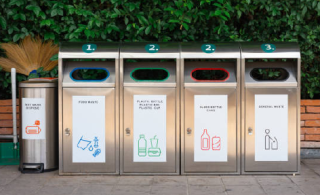Best Practices

Best practices for addressing plastic pollution include regulatory and policy interventions, behavioral and educational campaigns, partnerships, innovation, and locally appropriate technologies. It is important to consider all stages of the recycling process including collection, management, and disposal. It is critical for governments to increase collection and improve separation of materials. Strengthening collection services, especially in rural areas, can help localities collect waste and helps prevents pollution, all while increasing the value of recycled plastics.
Several factors impact successful implementation of plastic waste strategies, including geographic, financial, and other constraints. Many localities find that a combination of strategies is most beneficial to address plastic waste, including:
-
Regulation and policy. Governments and businesses can set targets or laws to limit plastic usage, encourage proper disposal of plastic waste, and phase out the most problematic plastics. Mandates that require data reporting are examples of mechanisms localities can use to manage plastic waste.
-
Measurement. Data allows organizations to target activities that will ultimately maximize source reduction, recycling, and composting of materials.
-
Behavior change and educational campaigns. Changing consumer behaviors and educating people about the negative impacts of plastic pollution can lower plastic consumption, reduce contamination in the recycling stream, and lead to enhanced plastic waste management.
-
Partnerships. Non-governmental organizations, local governments, businesses, the informal waste sector, and other interested parties can work together to maximize public awareness and execution of policies or educational campaigns focused on plastic pollution. These entities can also partner to fund and manage new infrastructure and technology. Partnerships are critical to developing and expanding markets for recycled plastic. For more information on recycling markets, read the Recycling Markets companion chapter (pdf)(29.5 MB) to the Best Practices for Solid Waste Management: A Guide for Decision-Makers in Developing Countries.
-
Innovation. For example, innovative systems should be expanded or developed to ensure that existing plastic products are reused as long as possible. Producers of plastic products can find new ways to ensure their products are designed to be easily reused. Community-based solutions may include creation of reuse or refill centers, or collaboration with stakeholders to increase the use of reusable food packaging and containers or package delivery containers in an area.
-
Technology and infrastructure. Access to and investment in locally appropriate technology and infrastructure can help localities better manage plastic waste and increase the value of recycled plastics. Innovation of new, environmentally sound technologies can help prevent, collect, reuse, and recycle more plastic waste. This can be done through machine learning to sort plastic waste, blockchain tools that foster recycling, washing bags to filter microplastics, and developing autonomous leakage removal systems. Investing in locally appropriate technology can aid in the development of sanitary landfills and increase closure of open dumpsites.
Check out a chart for information on the various challenges governments encounter when managing plastic waste and solutions that address such challenges (pdf)(31.6 MB).
